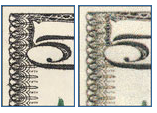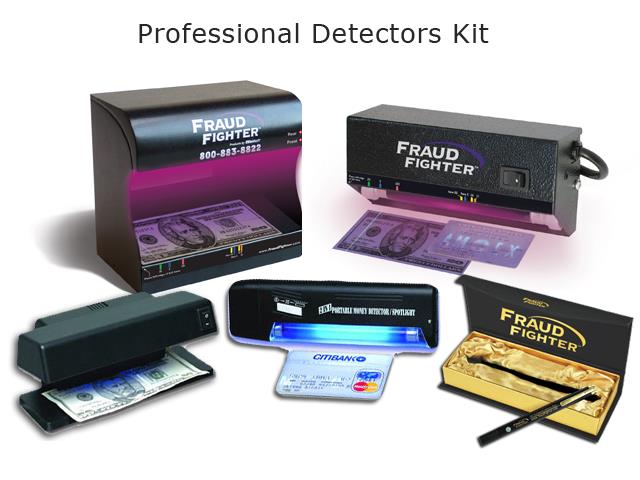 In 2013, the U.S. government says it recovered more than $88 million in counterfeit currency in the United States, and more than half of that was made using over-the-counter ink-jet or laser-jet home printer technology.
In 2013, the U.S. government says it recovered more than $88 million in counterfeit currency in the United States, and more than half of that was made using over-the-counter ink-jet or laser-jet home printer technology.
Bloomberg news service, tells how one woman in Florida:
"took $5 bills with a ...... watermark and soaked them with “Purple Power” degreaser. Next, she scrubbed off the ink with a toothbrush. After drying the now-blank notes with a hair dryer, she fed them through a Hewlett-Packard Co. 3-in-1 inkjet printer that emblazoned them with scanned images of $50 or $100 bills."
While the counterfeiting business used to require the advanced skill-set of the professional counterfeiter, who over the years would perfect his craft in an attempt to overcome the security features of U.S. currency, these days anyone with a digital printer can give it a try.
According to the same Bloomberg article, that is exactly what is happening in the United States:
"Statistics highlight the growth (of digital counterfeiting): In 1995, less than 1 percent of fake bills were produced on digital printers. In the last fiscal year, nearly 60 percent of the $88.7 million in counterfeit currency recovered in the U.S. was created using inkjet or laser printers, the Secret Service says."
Meanwhile, outside of the United States, most of the $68 million of counterfeit US dollars recovered in 2013 were made using commercial-grade offset presses. The Secret Service says those kinds of machines are far more capable of producing high-quality counterfeits which can "more easily escape detection by U.S. authorities and even operate with the backing of corrupt governments," according to Bloomberg.
Much of the counterfeit notes made in foreign countries are made in-collusion with governments unfriendly to the U.S. Or, in some cases (e.g. - Peru) where corruption has allowed certain government officials to profit from the US dollar counterfeiting industry, counterfeiting has attained a cottage-industry status, bringing prosperity to the villages where the operations are located. In fact, in recent years, it has been reported that as much as 1/3 of counterfeit notes circulating in the United States were produced in Peru.
Counterfeit currency has a long history in the United States. During the Civil War, one-third of all the money in U.S. circulation was fake, according to the Secret Service. (The agency was established in 1865 as a response to widespread counterfeiting.)

The best way to spot a fake bill these days? Experts disagree, but generally speaking, it is possible to look for obvious issues that occur when bills are printed on ink-jet or laser-jet printers. For example, blurry borders. Many of the images on counterfeit money aren't as crisp as the real deal.
Even the printed quality of the face of the historical figure on a US banknote will look different in a fake. According to the Secret Service, "The genuine portrait appears lifelike and stands out distinctly from the background", while counterfeit
 portraits are usually lifeless and flat. This is because of the "intaglio" printing process used by the US bureau of Engraving and Printing when they print US notes. The intaglio process enables extreme-fine line details on the portrait resulting from the highly-detailed printing plates that are engraved by hand with hundreds of individual ridges. This effect cannot be replicated using digital printers.
portraits are usually lifeless and flat. This is because of the "intaglio" printing process used by the US bureau of Engraving and Printing when they print US notes. The intaglio process enables extreme-fine line details on the portrait resulting from the highly-detailed printing plates that are engraved by hand with hundreds of individual ridges. This effect cannot be replicated using digital printers.

You can also look for tiny red and blue fibers that are embedded in real bills."Often counterfeiters try to simulate these fibers by printing tiny red and blue lines on their paper. Close inspection reveals, however, that on the counterfeit note the lines are printed on the surface, not embedded in the paper," the Secret Service says. There are even canine units trained to sniff out fake bills.
While the US Government claims counterfeit currency to represent only a fraction of the total quantity of currency in circulation, the Secret Service still made more than 3,600 counterfeiting arrests in 2013.


